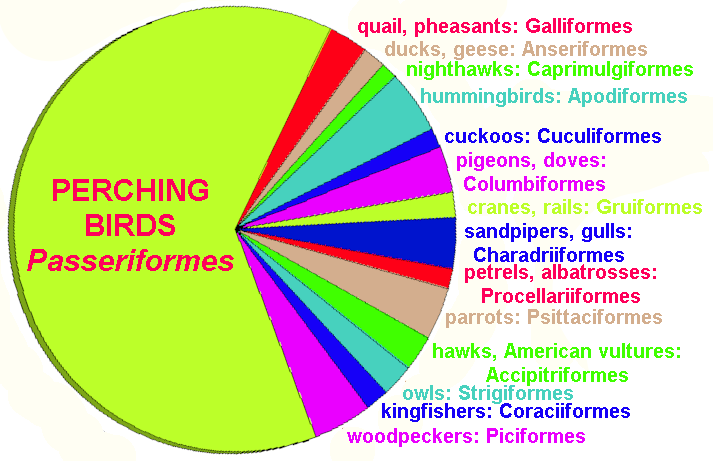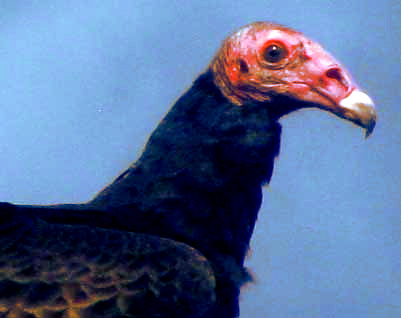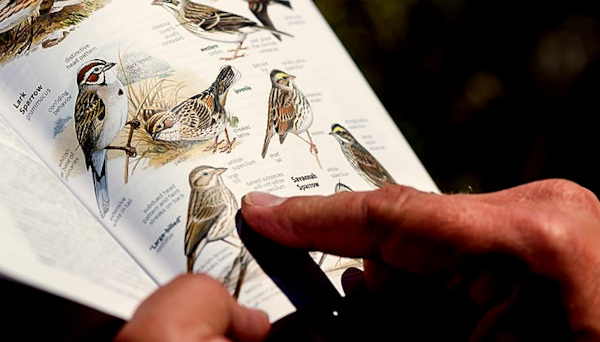When thinking about how the world's birds are related to one another, here's something worth considering:
by relative percentage of species

The most striking feature of the above pie chart is that the perching birds, more technically known as passerines -- members of the order Passeriformes -- supply more species to the bird world than all other bird orders combined.

However, other details relating to the chart also are interesting. First of all, only 15 bird orders are represented on the chart, while nearly everyone agrees that more than that exist. The chart only shows orders containing over 120 species. The Magnificent Frigatebrid at the right isn't represented on the chart because it, as well as cormorants, anhingas and boobies, all belong to the Suliformes Order, holding only 61 species. The Hoatzin and Cuckoo Roller orders contain only one species apiece. The Ostrich, Rhea, Sunbittern, and Seriamas orders contain only two species each. A page at the WorldBirdNames.Org website provides a list of all the bird orders, with their numbers of species.

That website emphasizes that "Improving sets of DNA sequences are revolutionizing the Avian Tree of Life." In other words, because of ever-new studies, our concepts about bird evolution are changing fast. In older field guides, the Turkey Vulture at the left inhabited pages bearing members of the Hawk Order, Falconiformes. However, late in the 20th century field guides began placing them among storks and herons, of the Stork Order, the Ciconiiformes. But, as of 2021, based on "multi-locus DNA studies," they were said to be in the newly erected Hawk Order the Accipitriformes... or maybe they should have their own order! In fact, there's little certainty about the number of bird orders, and which families and species should be included in which orders. Even the whole concept of "bird orders" is under review.
For us amateurs it's good enough to know that maybe between 20 and 45 bird orders exist, and that the above pie chart, while grossly simplified, does a good job orienting us toward the main bird groupings. It shows that when we go birding probably we should expect to see more perching birds than anything else. Cuckoos, owls, kingfishers, woodpeckers, ducks, hummingbirds and such are kind of special, if only because they're so unrelated to most birds that they're not members of the Perching Bird Order, the Passeriformes.
Also, the chart tells us that, if we're serious about appreciating bird diversity, the Perching Bird Order, the Passeriformes, needs special attention. We need to know that the main distinguishing features of perching birds includes these:
- perching bird feet have 3 unwebbed toes in front and one strong, flexible toe in the back (the hallux, very useful for perching)
- chicks are completely featherless and helpless when they hatch and must be fed by parents
- many of the largest groups of birds, and our most familiar species, are perching birds; just a few are:
- sparrows
- warblers
- vireos
- wrens
- flycatchers
- chickadees
- orioles
- the order is divided into 2 suborders
- The Passeri, who learn their songs by listening to other birds of their species
- The Tyranni, mostly South American, are born knowing their songs
You may want to review our Pigeon-Holing our Discoveries page.
ORDERS & FIELD GUIDES
Having your thoughts about bird orders in order is especially useful when using field guides. Nearly all birdng field guides order their pages according to the bird orders. If you spot a sparrow, you won't have to wade through all the hawks, sandpipers, and seagulls to find out which sparrow you have.
